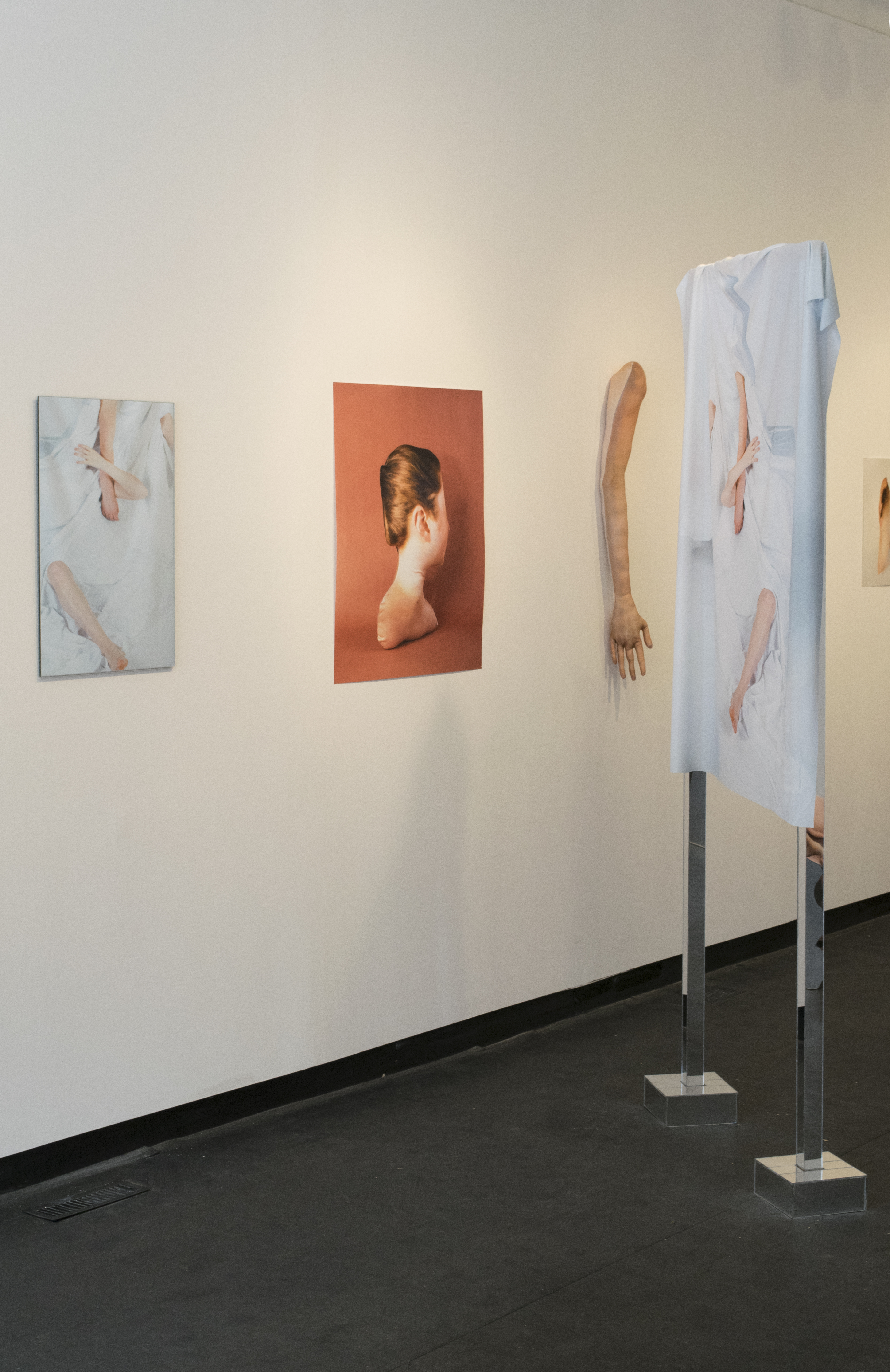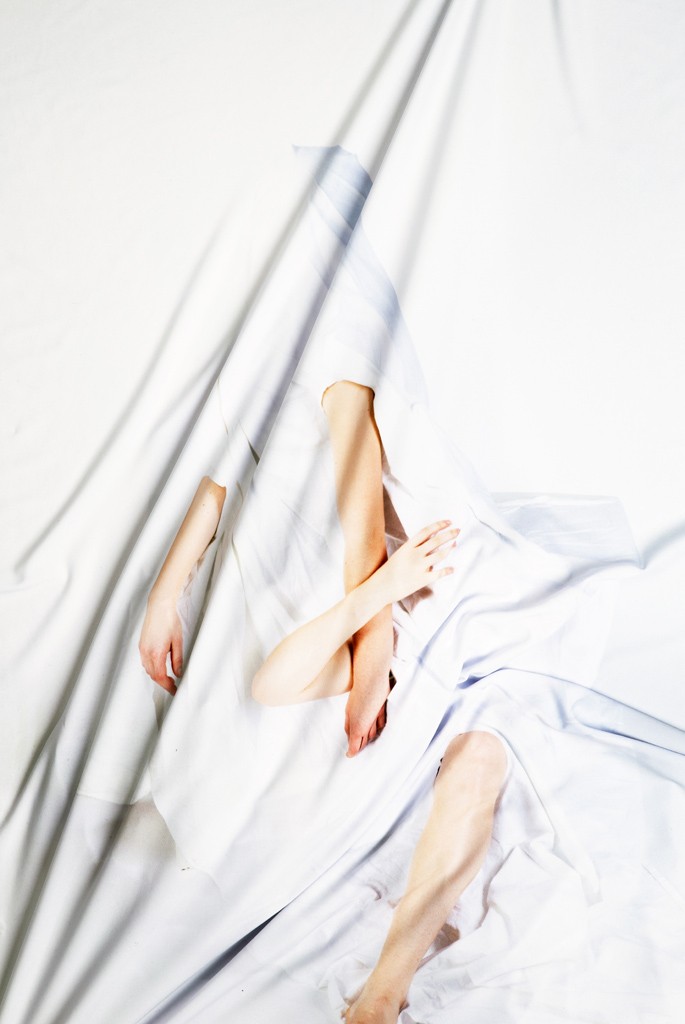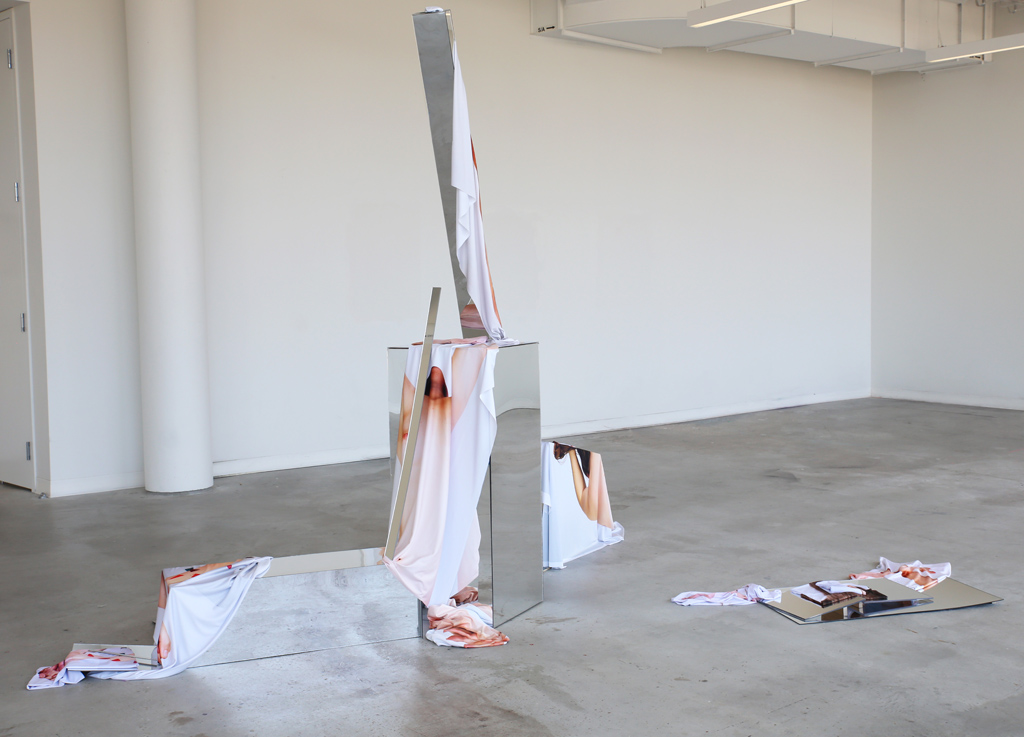MAINSPACE EXHIBITION /

I Never Recognized Her Except in Fragments
Hannah Doucet
July 8 – August 6, 2016
Exhibition Description
“Sometimes I recognized a region of her face, a certain relation of nose and forehead, the movement of her arms, her hands. I never recognized her except in fragments, which is to say that I missed her being, and that therefore I missed her altogether. It was not she, and yet it was no one else… I was struggling among images partially true, and therefore totally false.” [1]
Hannah Doucet looks at images of women; both private and public, and particularly those within mainstream media outlets. Most of what Doucet sees are fragmented women – distorted bodies, recognizable as what they are, but only through the summation of their parts. Within this body of work, Doucet probes these tropes of fragmentation and distortion that she observes in contemporary culture.
Through photographs, video and sculpture, I Never Recognized Her Except in Fragments grapples with issues of representation and materiality inherent in the medium of photography. By privileging the flat mirror (whether as an object or as a mechanical component within a camera) and the flat photograph for our understanding of our bodies, we create for ourselves a false two-dimensional body. The exhibition contains images of bodies printed on fabric, which through physical manipulation of the fabric become moldable, textural, and versatile objects, further distorting the body. Through a repetition of imagery and a process of re-photographing, an overt tension is created between representation and the material presence of the photographic object. By addressing the materiality of a photograph the physicality of women’s bodies is simultaneously addressed. Through the creation of a shifting, undulating surface to the image, you are forced to look beyond the referent and to consider it for what it is – a two dimensional representation of something three-dimensional. What are the implications of this shift of dimensionality? The work within this exhibition struggles to re-insert materiality within two-dimensional representations of women, a clumsy and impossible task.
[1] Roland Barthes, Camera Lucida (New York: Hill and Wang, 1981), 65-66










On I Never Recognized Her Except in Fragments
What does my body look like? Hannah Doucet’s exhibition I Never Recognized Her Except In Fragments approaches the contradictions entangled in this question, and how the instruments of representation tend to fall short of answering it. By placing materiality in a negative dialectic with the image, Doucet’s attention to surface amplifies the inescapable flattening of the photograph. For Doucet, inaccuracy is most prominent in the body instantiated through mimetic objects and exteriors; the viewer seeks to link the image to a subject, yet it can never be secured or grasped in any real way.
Through a process of printing on textiles, arranging, and re-photographing, the figures found in Doucet’s work become compressed and leave us with the unsettling task of understanding exactly what we’re looking at. I Never Recognized Her Except In Fragments makes plain in its title that the traditional function of portrait – to represent one person for another – is subverted through Doucet’s handling of her models’ image. In her video Inserting Stillness the viewer is shown the gestures of manipulation that are otherwise frozen in still photographs while still eluding unbroken or didactic depiction. The images dazzle as both cosmetic and classical, but beneath the sheen one finds a misaligned deltoid, or a wrist so long and skinny it appears unreal. Doucet’s distortion of the model and the picture begins with the photograph and the mirror – the twin pillars of self-imaging – and where they fail to deliver on their promise of faithful portrayal.
Doucet’s transfer of the photograph onto diaphanous material becomes a gesture in which the living subject is effectively enshrouded in their image. Jacques Lacan argued that the picture is “a trap for the gaze” and this sentiment is both reflected and refused by Doucet’s cloaked figures. The body, concealed by the graphic scrim or inflated by the stuffed sculpture, is made absent. Her compositions subtly remind the viewer that there is no flesh to linger on, relinquishing the photographic endeavour to possess its subject. In a series of untitled works, Doucet offers fractured studies of hair, hands, and arms: the parts that usually channel various codified signals of personality and articulation, are here made totally expressionless. By reiterating the flat image, her work withholds the sympathetic visage usually found in portrait and returns to a study of photographic fallacy. This interference reveals what is often unrecognizable in a photo and becomes a visualization of the way thinking about your body feels.
The inability to secure a clear image of one’s physical form, or exaggerating that image, is clinically described as body dysmorphia: a mental disorder in which you cannot stop thinking about your appearance. Though the condition is reported to affect females and males equally, it is arguably the female body that most consistently acts as the substance and terrain of falsified representation, where physique and value are conflated and warped. Doucet’s work is a reminder that the female subject is often trapped between an individual embodiment and a social totality; whose base presence is transformed into a depthless image that ignores the vitality, animation, and multitudes of the living body. I Never Recognized Her Except In Fragments reinforces that self-conception is often too vast and complex to be rendered in two dimensions, where the body is made into strange and opaque shapes.
— Jessica Evans
Biographies
Hannah Doucet is a photo-based artist from Winnipeg, Canada. Her practice is rooted within the medium of photography, with material explorations also extending to video, textile, sculptural, and installation based processes. Her work explores the body, representation, materiality and failure within the medium of photography. She received her BFA Honours from the University of Manitoba in 2015. Hannah has exhibited in alternative spaces and artist-run centres throughout the city of Winnipeg, with a solo exhibition, Present Absence at C Space in 2015. She has also exhibited nationally, at Art Mur (Montreal) and Avenue (Vancouver), with upcoming participation in a group exhibition Proof 23 at Gallery 44 (Toronto) and a solo exhibition at The New Gallery (Calgary) in 2016. She is a co-founder of SCAN, a contemporary art publication based in Winnipeg as well as a committee member for Flux Gallery a newly initiated gallery project for early-stage emerging artists.
Jessica Evans is an artist and writer based in Vancouver, Canada
